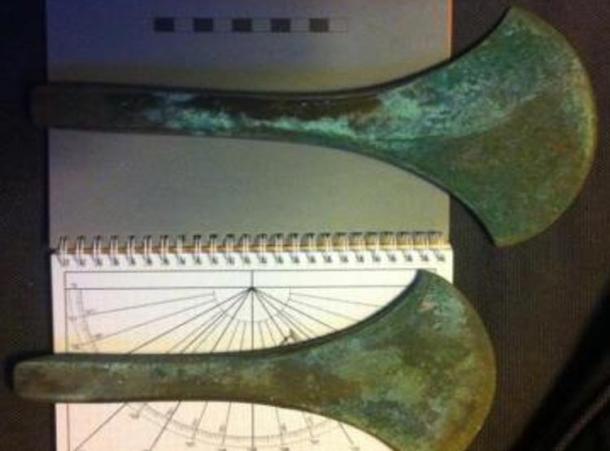
Five Huge Bronze Age axes discovered in a field in Jutland, Denmark
Five Bronze Age axes, twice the size of those normally discovered, have been discovered in a field near Boest, near Nørre Snede in Jutland, Denmark. The axes have been dated to 1600 BC, which means they are one of the earliest Bronze Age finds in Denmark.
The first pair of axes were discovered by the brother-in-law of a pine tree farmer who was about to plant his new crop. When archaeologists visited the site, they found three more. The discovery has attracted archaeologists from all over, drawn to a hugely important find.
The axe heads contain two pounds of pure metal and are 12 inches (30 centimeters) wide. The farmer who owns the field, Esben Arildskov, asked his brother-in-law to use a metal detector in the field before he started planting, as he didn’t wanted to destroy anything with any historical value.

Image of the Axe heads found at the site. 2015 (sciencenordic.com)
“Five such Bronze Age axes have been found in all Northern Europe to date, and then we go and five more in one go. That's fantastic” said archaeologist Constanze Rassmann, speaking to the Science Nordic website. Ms Rassmann is the curator of the Museum Midtjylland in Denmark and she strongly suspects the axes were deposited deliberately as an offering to the gods. The main reason for this is that they were deposited next to and on top of each other. Furthermore, on the same site, the archaeologists found evidence indicating the former existence of four rows of wooden posts, each post the height of a man, stretching for a distance of at least 100 metres (328.084 feet) across the landscape. The posts eventually disappear into woodland but the archaeologists are hoping to conduct a thorough excavation at a later date in order to find out more about them.
- The Surprising and Iconic Bronze Age Egtved Girl: Teenage Remains Tell a Story of Trade and Travel
- The Bronze Age Srubna Culture and their Unique Timber Graves for the Dead
- Bronze Age gold rings of a high-status person found in Wales

Constanze Rassman holding one of the bronze axes found at the site. 2015. (sciencenordic.com)
Rassmann told a local newspaper in Skanderborg that, to date, only five other axes from the same period have been found across Germany, Denmark and Sweden. It is this that makes the finding of these axe heads such a ground-breaking discovery.

Bronze Age swords and other artifacts in the Nationalmuseet (National Museum) in Copenhagen, Denmark. Photo by Simon Burchell, 2011. (Wikimedia Commons)
French antiquary Mahudel was the first to note that bronze items were generally found in graves and from this he proposed that discoveries of stone, bronze and iron items could be dated according to a particular sequence. This idea was subsequently adopted by English antiquaries, notably William Borlase (1696-1772) and the chronology had become generally accepted by the end of the eighteenth century. It was later called the ‘Three Age’ system of classification by Danish archaeologists.
The Bronze Age in Britain began around 2,000 BC and the period is marked by the introduction of bronze tools and weapons from the European mainland. Bronze is formed from the combination of a small amount of tin (around 10 percent) with the remaining metal (90 percent) being copper. The Bronze Age in southern Europe began on the island of Crete which acted as a base for the export of bronze items to Europe. The first bronze weapons were crafted by the Mycenaean culture of Greece. The Mycenaeans originally came from Russia. When they arrived in Greece they began to trade with the Minoans. The Bronze Age was introduced into Britain by the ‘Beaker People’ named after their bell-shaped ‘beaker’ pottery.
Scandinavian Bronze Age peoples joined their other European counterparts later in history through trade in which ships played an important part. Rock carvings across Scandinavia depict these ships and tombs and burial monuments consisting of individual standing stones were often laid out in the form of a boat or ship. The most well-known of these monuments include Ale’s Stones in southern Sweden, Anundshög (also in Sweden), Kerteminde fjord in Denmark and Altes Lager Menzlin near Anklam in Western Pomerania, Germany.
- Archaeologists discover Bronze Age palace and huge trove of grave goods in Spain
- 3000-year-old bronze sword discovered in China
- A rich Celtic Iron Age tomb discovered with stunning artifacts

Two of the Viking stone ships (burial grounds) at Badelunda, near Västerås, Sweden. Photo by Berig 2005. (en.wikipedia.org)
The Nordic Bronze Age began during a period of climate change around 2700 BC which encouraged a dense population and a rich agricultural economy, including the cultivation of grapes in Sweden and millet in Denmark. Written sources from this period are rare but stone carvings indicate the veneration of a pair of twin gods including a mother goddess figure. Sacrifices of animals, weapons, personal items and humans were sometimes made, usually near water. The stone carvings include early depictions of deities that may have been early manifestations of the later Viking gods, such as Thor, Odin and Tyr. Another figure, holding a bow, may have represented the god Ullr.
The axe heads found at the Boest site have now been taken to Museum Midtjylland so that conservation work can be carried out on them. When this is complete they will be taken to the National Museum of Denmark in Copenhagen.
Featured Image: Denmark during the Bronze Age. Image by: State Danish Archives. 2013. (Wikimedia Commons)
















Comments
Hi, I am afraid to admit that sometimes, just to fill in background, I slip in some information from Wikipedia, although I try not to generally. Further investigation on this exact point has led me to conclude that the Wiki article I used as a source at this point in the article was referring to the rock carvings at Tanumshede, which indicate a possible pair of twin gods, possibly rivals (there are many ‘rival gods’ in the ancient world – Osiris and Set in Egypt being just one example – fighting each other, and also depict what may be a ‘wedding ceremony’ between a god and a goddess. You can find further information about Tanumshde here: http://www.vastsverige.com/en/Tanum/products/49992/Vitlycke-Hallristning...
Dear Mr. Robin Whitlock. Would you be so kind as to reveal (preferably in detail) the sources you have for the following comment near the end of you article: "Written sources from this period are rare but stone carvings indicate the veneration of a pair of twin gods including a mother goddess figure."
Absolutely right Nathan.
You make excellent points. And whenever there is strong evidence of a stone or metal artifact being much older than and outside the expected and accepted dating period, the "scientists" will summarily give the "accepted" date and throw out and ignore the actual and stronger data pointing to a much older date. This happens, not because scientists are inherently dishonest, but because they know their funding sources will dry up if they don't toe the line.
If you read the article carefully, you will see that archaeologists date such objects based on “generally accepted” dates based on a system devised a couple hundred years ago.
In reality, we have no way of dating metal or stone objects, other than finding them in place with other objects we can date. Even then, most dating methods have severe limitations on accuracy.
This means, unfortunately, that we always will have a hard time putting accurate time periods on most archaeology. This runs against the grain of almost all humans, so archaeologists have a tendency to put “firm” dates on things that may have a variance of thousands of years. These axes could come from 1700 BCE, but also 3000 BCE, or 1000 BCE. We just don’t have the means to tell in most instances.
Tom Carberry